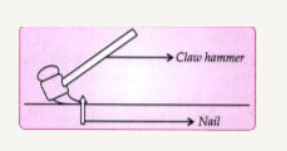Both a pair of scissors and a pair of pliers belong to the same class of levers. Name the class of lever. Which one has mechanical advantage less than 1?
Step-by-Step Solution:
1. Identify the Class of Lever:
- Both scissors and pliers belong to the same class of levers.
- They are classified as Class 1 levers.
2. Understanding Class 1 Lever:
- In a Class 1 lever, the fulcrum is located between the effort (force applied) and the load (weight to be moved).
- A simple diagram can be represented as follows:
Load(L)−−−−Fc–rum(F)−−−−Effort(E)
3. Mechanical Advantage Calculation:
- The mechanical advantage (MA) of a lever is calculated using the formula:
\(
\text{Mechanical Advantage (MA)} = \frac{\text{Effort Arm}}{\text{Load Arm}}
\)
- In the case of scissors and pliers, the load arm (distance from the fulcrum to the load) is greater than the effort arm (distance from the fulcrum to the point where effort is applied).
4. Conclusion on Mechanical Advantage:
- Since the load arm is greater than the effort arm, the mechanical advantage will be less than 1.
- Therefore, both scissors and pliers have a mechanical advantage of less than 1.
5. Final Answer:
- The class of lever is Class 1.
- The mechanical advantage is less than 1 for both scissors and pliers.
---
- Both scissors and pliers belong to the same class of levers.
- They are classified as Class 1 levers.
- In a Class 1 lever, the fulcrum is located between the effort (force applied) and the load (weight to be moved).
- A simple diagram can be represented as follows:
Load(L)−−−−Fc–rum(F)−−−−Effort(E)
- The mechanical advantage (MA) of a lever is calculated using the formula:
\(
\text{Mechanical Advantage (MA)} = \frac{\text{Effort Arm}}{\text{Load Arm}}
\)
- In the case of scissors and pliers, the load arm (distance from the fulcrum to the load) is greater than the effort arm (distance from the fulcrum to the point where effort is applied).
- Since the load arm is greater than the effort arm, the mechanical advantage will be less than 1.
- Therefore, both scissors and pliers have a mechanical advantage of less than 1.
- The class of lever is Class 1.
- The mechanical advantage is less than 1 for both scissors and pliers.
Topper's Solved these Questions
- MACHINESBOOK - ICSECHAPTER - MACHINESEXERCISE - EXERCISE-3(A) MULTIPLE CHOICE TYPE
5 Videos
- MACHINESBOOK - ICSECHAPTER - MACHINESEXERCISE - EXERCISE-3(A) NUMERICALS
12 Videos
- MACHINESBOOK - ICSECHAPTER - MACHINESEXERCISE - EXERCISE-3(B) NUMERICALS
11 Videos
- HOUSEHOLD CIRCUITS BOOK - ICSECHAPTER - HOUSEHOLD CIRCUITS EXERCISE - EXERCISE -9(B) (MULTIPLE CHOICE TYPE)
2 Videos
- QUESTION PAPER 2022 TERM 1BOOK - ICSECHAPTER - QUESTION PAPER 2022 TERM 1EXERCISE - MULTIPLE CHOICE QUESTIONS
40 Videos
Similar Questions
Knowledge Check
The lever for which mechanical advantage is less than 1 has:
Afulcrum at the mid point between load and effort.Bload between effort and fulcrum.Ceffort between fulcrum and loadDload and effort acting at the same point.
Which one of the following belongs to the same class?
View SolutionClass III levers have mechanical advantage less than 1. why are they then used ?
View SolutionGive one example each of a class I lever where mechanical advantage is (a) more than 1, and (b) less than 1.
View SolutionThe diagram below shows a claw hammer used to remove a nail :

(i) To which class of lever does it belong?
(ii) Give one more example of the same class of lever mentioned by you in (i) for which the mechanical advantage is greater than one.
View SolutionThe diagram alongside shows a claw hammer used to remove a nail :
Give one more example of the same class of lever mentioned by you in (i) for which the mechanical advantage is greater than one.

View SolutionA pair of scissors has its blades 15 cm long, while its handles are 7⋅5cm long. What is its mechanical advantage ?
View SolutionIn a class-one lever, mechanical advantage can be either less than 1 or greater than 1.
View Solution
